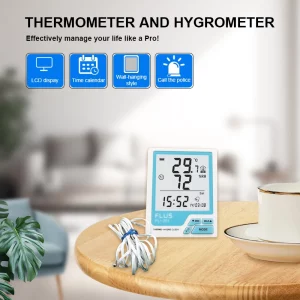The principle behind the operation of a handheld hygrometer lies in its ability to measure the amount of water vapor present in the air. This is achieved through the use of various sensing elements, such as capacitive, resistive, or thermal sensors. These sensors work by detecting changes in electrical conductivity, resistance, or temperature, which are directly influenced by the moisture content in the air. By accurately measuring these changes, the hygrometer is able to provide a precise reading of the relative humidity in the surrounding environment.

The structure of a handheld hygrometer typically consists of a display screen, a sensor, and a control interface. The sensor is the heart of the device, responsible for capturing the data related to humidity levels. This data is then processed and displayed on the screen, allowing the user to easily interpret the readings. The control interface enables the user to operate the hygrometer, providing options for calibration, setting alarms, and accessing historical data.
One of the key advantages of a handheld hygrometer is its portability and ease of use. Its compact size and lightweight design make it convenient for users to carry and use in various locations. Whether it’s for checking the humidity levels in a room, a storage area, or a production facility, the handheld hygrometer offers a practical solution for on-the-go monitoring.
When it comes to the applications of a handheld hygrometer, the possibilities are diverse. In residential settings, it can be used to ensure optimal humidity levels for indoor comfort and to prevent issues such as mold growth and moisture-related damage. In commercial and industrial environments, it plays a crucial role in maintaining ideal conditions for processes, products, and equipment. From pharmaceuticals and food storage to HVAC systems and manufacturing facilities, the handheld hygrometer is an indispensable tool for quality control and safety.
The importance of accurate humidity measurement cannot be overstated, especially in environments where precise control is essential. For instance, in laboratories and cleanrooms, maintaining specific humidity levels is critical for the integrity of experiments and the performance of sensitive equipment. In museums and archives, controlling humidity is vital for preserving valuable artifacts and documents. In these scenarios, a handheld hygrometer serves as a reliable instrument for ensuring that the required humidity conditions are consistently met.
In conclusion, the principle and structure of a handheld hygrometer are fundamental to its functionality and significance in various settings. By leveraging advanced sensing technology and user-friendly design, this device empowers individuals and organizations to monitor and manage humidity levels with precision and efficiency.
